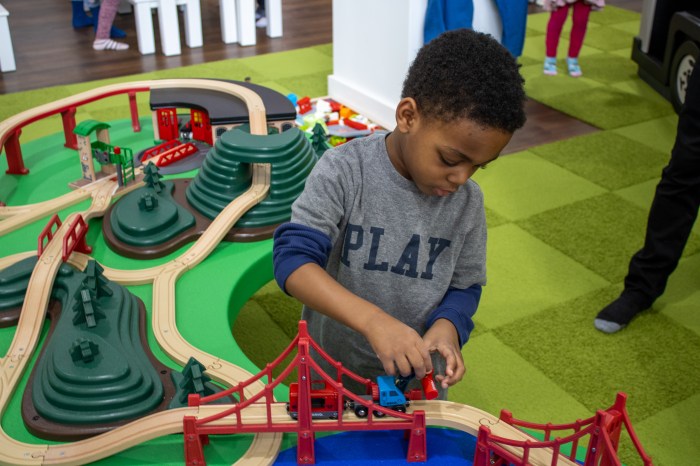By Daniel Massey
It has, over its 38-year history, been home to the Mets and Yankees, Jets and Giants, the Beatles and the Pope. It now has cracks, leaks and loose wires, but Flushing’s Shea Stadium is going to be around for a few more innings.
A city engineering report completed in March said Shea Stadium was falling into a state of disrepair. But a widening city budget deficit and change in priorities since Sept. 11 mean the 38-year old home of the New York Mets will not yet be replaced by owner Fred Wilpon’s $800 million dream of an Ebbets Field replica. Instead, the Parks Department is planning an $11 million overhaul of the stadium.
The new ballpark, which was to be ready for Opening Day in 2005, was to recall the fabled home of the Brooklyn Dodgers. But Shea has a memorable history in its own right.
Named after attorney William Shea, who brought National League baseball back to New York after the Dodgers and Giants left town, the stadium opened April 17, 1964, at a construction cost of $28.5 million. Shea christened the park with two symbolic bottles of water: one from the Gowanus Canal, near Ebbets Field, and the other from the Harlem River, near the former New York Giants home, the Polo Grounds.
The Mets lost the first game 4-3 to the Pittsburgh Pirates on a ninth inning single by hall of famer Bill Mazeroski. Later that year, on Father’s Day, Philadelphia’s Jim Bunning pitched the first and only perfect game in Shea Stadium history. The Mets lost 6-0.
Fans finally had something to cheer about a year later, but it was the Beatles, not baseball, that sparked the roar. More than 60,000 screaming fans packed Shea Aug. 15, 1965, for the group’s first outdoor stadium concert. The Rolling Stones, The Who, and Simon & Garfunkel have also performed at Shea over the years. Throughout its history the stadium has hosted soccer and boxing matches and even received a visit from Pope John Paul II.
Now home only to the Mets, the Yankees and the NFL’s Jets and Giants were also once housed at Shea. It was the Jets permanent home before former owner Leon Hess moved them to New Jersey’s Giants Stadium in 1984 and served as a temporary home for the Giants, in 1975, and Yankees, from 1974-1975. Before making his famous guarantee that the Jets would beat the Baltimore Colts in Super Bowl III, Joe Namath led his team to victory against the Oakland Raiders in the AFL championship game at Shea.
The stadium was particularly busy in 1975, hosting the Mets, Yankees, Giants and Jets, the first and only time two professional baseball and football teams played home games in the same facility in the same year.
But more than any team, Shea Stadium has come to be associated with the Mets, who have captured four Eastern Division titles, two Wild Card titles, four National League Pennants and two World Series crowns in their 40-year history. The Mets world championships, won in 1969 against the Baltimore Orioles and in 1986 against the Boston Red Sox, were both clinched at Shea.
Shea has been home to some odd occurrences, perhaps the most dangerous of which was a 21-gun salute that went awry on Army Day in 1975. The park filled with smoke, part of the outfield fence was blown away and another part was set on fire.
Two years earlier, Pete Rose, of the Cincinnati Reds, faced a shower of debris from Shea fans after he started a fight with Mets shortstop Buddy Harrelson following a double play in the Game 3 of the 1973 National League Championship Series. When he returned to his position in left field, a deluge of objects flew down from the upper deck, including a whiskey bottle that landed feet away from Rose.
To avoid a forfeit, the Mets sent a peacekeeping delegation comprised of Tom Seaver, Willie Mays, Cleon Jones and manager Yogi Berra to calm the fans. They simmered down, but returned the next day with signs reading “This Rose Smells,” and “Rose is a Weed.”
During Game 6 of the 1986 World Series, another expressive Mets fan, Michael Sergio, parachuted onto the playing field, disrupting play. He was sentenced to 100 hours of community service and fined $500.
In 1999 Robin Ventura hit a game-winning grand slam in a playoff game against the Atlanta Braves that counted only as a single when a celebration led by teammate Todd Pratt prevented him from reaching second base.
From a ground ball trickling through Red Sox first baseman Bill Buckner’s legs in 1986 to Tom Seaver’s near no-hitter in 1969, Shea has witnessed its share of memorable baseball moments. Pratt even accounted for his own heroics in 2000 when his home run off Matt Mantei beat the Arizona Diamondbacks in a wildcard playoff, the only series-ending homer in Shea post season history.
In 2001, following the Sept. 11 terrorist attacks, the stadium served an even more important role than playing home to the Mets. It was filled with food and supplies and provided a resting spot for out-of-town workers helping with the World Trade Center rescue effort. On Sept. 21, in the first game after the attacks, an 8th inning Mike Piazza home run gave the Mets a comeback victory over the Atlanta Braves and was looked upon by many as symbolic of the resolve of all New Yorkers.
Reach reporter Daniel Massey by e-mail at TImesledger@aol.com or call 229-0300, Ext. 156.

































